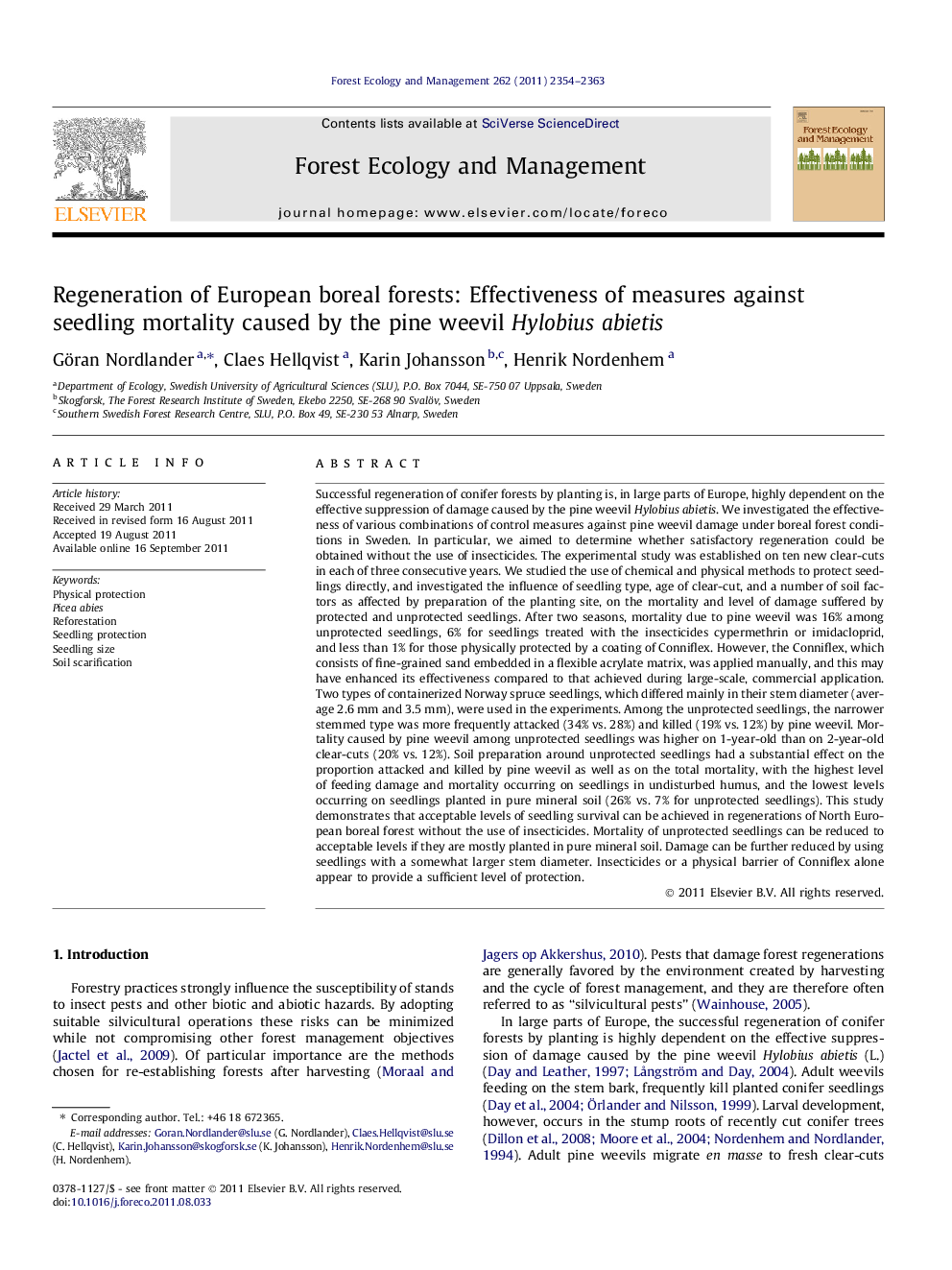| کد مقاله | کد نشریه | سال انتشار | مقاله انگلیسی | نسخه تمام متن |
|---|---|---|---|---|
| 87822 | 159267 | 2011 | 10 صفحه PDF | دانلود رایگان |

Successful regeneration of conifer forests by planting is, in large parts of Europe, highly dependent on the effective suppression of damage caused by the pine weevil Hylobius abietis. We investigated the effectiveness of various combinations of control measures against pine weevil damage under boreal forest conditions in Sweden. In particular, we aimed to determine whether satisfactory regeneration could be obtained without the use of insecticides. The experimental study was established on ten new clear-cuts in each of three consecutive years. We studied the use of chemical and physical methods to protect seedlings directly, and investigated the influence of seedling type, age of clear-cut, and a number of soil factors as affected by preparation of the planting site, on the mortality and level of damage suffered by protected and unprotected seedlings. After two seasons, mortality due to pine weevil was 16% among unprotected seedlings, 6% for seedlings treated with the insecticides cypermethrin or imidacloprid, and less than 1% for those physically protected by a coating of Conniflex. However, the Conniflex, which consists of fine-grained sand embedded in a flexible acrylate matrix, was applied manually, and this may have enhanced its effectiveness compared to that achieved during large-scale, commercial application. Two types of containerized Norway spruce seedlings, which differed mainly in their stem diameter (average 2.6 mm and 3.5 mm), were used in the experiments. Among the unprotected seedlings, the narrower stemmed type was more frequently attacked (34% vs. 28%) and killed (19% vs. 12%) by pine weevil. Mortality caused by pine weevil among unprotected seedlings was higher on 1-year-old than on 2-year-old clear-cuts (20% vs. 12%). Soil preparation around unprotected seedlings had a substantial effect on the proportion attacked and killed by pine weevil as well as on the total mortality, with the highest level of feeding damage and mortality occurring on seedlings in undisturbed humus, and the lowest levels occurring on seedlings planted in pure mineral soil (26% vs. 7% for unprotected seedlings). This study demonstrates that acceptable levels of seedling survival can be achieved in regenerations of North European boreal forest without the use of insecticides. Mortality of unprotected seedlings can be reduced to acceptable levels if they are mostly planted in pure mineral soil. Damage can be further reduced by using seedlings with a somewhat larger stem diameter. Insecticides or a physical barrier of Conniflex alone appear to provide a sufficient level of protection.
► Seedling mortality due to pine weevil was reduced by silvicultural and other measures.
► Soil scarification followed by planting in mineral soil reduced damage substantially.
► A fallow period of 2 years gave less damage than a one-year fallow period.
► Seedlings with a larger stem diameter were less frequently attacked and killed.
► Successful regeneration can be achieved in boreal forests without reliance on insecticides.
Journal: Forest Ecology and Management - Volume 262, Issue 12, 15 December 2011, Pages 2354–2363